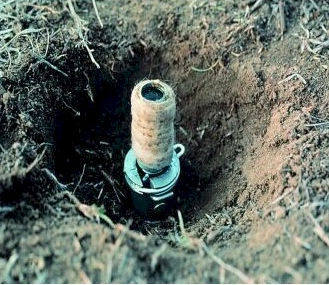This is a follow-up to our recent article. Without government, who would leave unprotected cyanide bombs outside to kill people’s dogs?
Every reasonable person is cautious when they go out for a hike. They keep their eyes and ears peeled for any potential predators, and they make sure to watch their step. Unfortunately, being cautious isn’t so helpful when you’re dealing with the unexpected. It doesn’t help you when you don’t know what to look for, says Joshua Krause of
Ready Nutrition.
That’s why so many people were shocked and horrified to hear about a recent incident involving a teenage boy and his dog in Idaho. Most people are completely unaware of the device that killed his dog.
14-year-old Canyon Mansfield was out playing with his dog in the backyard of his parent’s rural property, when he saw an object on the ground that he mistook for a sprinkler head. When he touched it, the object erupted in a cloud of cyanide.
The explosion sprayed the boy and his 3-year-old, 90-pound (40 kg) pet with toxic cyanide gas, according to the boy’s mother, Theresa Mansfield.
“Canyon said there was a bang like a bomb, then an explosion of an orange substance that covered him and Casey, who was writhing in pain on the ground before he died right in front of Canyon,” she said.
Her husband, Pocatello physician Mark Mansfield, rushed to the scene and pounded on the dog’s chest in a futile effort to revive the animal.
The family and first-responders underwent decontamination procedures and the boy, who was sprayed in the face, was tested for cyanide poisoning at a hospital for the second time Friday, officials and family members said.
What the boy encountered is called an M44. It’s a type of trap that is laid in rural areas by Wildlife Services, usually at the request of local farmers and ranchers. It’s a spring-loaded cylinder that is buried partially in the ground, with a bait scented cloth exposed to the surface. When an animal tugs on it, the M44 releases a dose of sodium cyanide into the animal’s mouth.
The device has been widely criticized over the years because it is so indiscriminate. Though it does successfully kill thousands of predators that threaten livestock, the M44 also frequently kills animals that aren’t intended for the trap, including pets and endangered species.
And from time to time, humans are injured by these devices as well. In 2003 a man from Utah was out with his friend, riding ATVs on BLM land. He found what he thought was a surveyor’s stake, and tried to pick it up. It turned out to be an M44, and it blasted him with cyanide. For years following the incident, he suffered from high blood pressure, severe breathing problems, and frequent vomiting.
So you may be wondering how you can avoid these devices. For starters, the M44 is normally laid on or near private property that houses livestock. So if you’re hiking in an area that isn’t near any agriculture, then you should be fine. These devices are often accompanied by warning signs, but it seems that isn’t always the case; or at the very least the signs aren’t always visible. In the cases I described above, nobody reported seeing any warning signs, so you need to know what to look out for. Here’s what an M44 looks like after it’s been partially buried:
That cloth roll is always exposed to the surface, though it isn’t always that color. Sometimes it’s a pinkish color.
You should be especially careful if you’re out walking your dog. These things are often scented to attract coyotes, but what attracts one kind of canine will also attract any kind of canine. So if you’re walking in an area where livestock is nearby, it might be best to keep your dog on a leash and watch where your pet is sniffing around.
And as a rule of thumb, if you ever see anything metallic sticking out of the ground, think twice before picking it up. It’s not exactly clear how long these things can remain potent, and it’s not clear how many of them remain in the ground, unaccounted for. Over time, erosion, corrosion, and decomposition of the cloth could make them unrecognizable.
Joshua Krause was born and raised in the Bay Area. He is a writer and researcher focused on principles of self-sufficiency and liberty at Ready Nutrition. You can follow Joshua’s work at our Facebook page or on his personal Twitter.
Joshua’s website is Strange Danger
This information has been made available by Ready Nutrition

